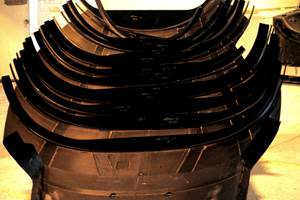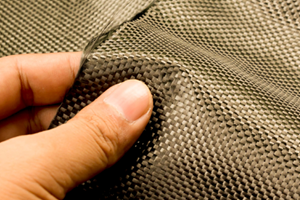Going discontinuous, for continuous improvement
The HiPerDiF (High Performance Discontinuous Fibre) project is exploring an alternate way of producing high-performance carbon fiber composites: start with discontinuous, rather than continuous fibers.
A research program in the UK is attempting to achieve a fundamental step-change in the composites industry. HiPerDiF (High Performance Discontinuous Fibre) project, which began in December 2017 and runs through 2020, is a program funded by the UK’s EPSRC (Engineering and Physical Sciences Research Council: https://gow.epsrc.ukri.org/NGBOViewGrant.aspx?GrantRef=EP/P027393/1 ) that is exploring an alternate way of producing high-performance carbon fiber composites: start with discontinuous, rather than continuous fibers. The program, led by Professor Ian Hamerton of the Bristol Composites Institute (ACCIS) at the University of Bristol, has an impressive roster of project partners, including Airbus, Toyota, BAE Systems, ELG Carbon Fibre Ltd., Hitachi Chemical Co. Ltd., and several composite material suppliers including Solvay and Hexcel.
My colleague Ginger Gardiner has already blogged about this topic, describing several US entities with the same idea (here’s the link: https://www.compositesworld.com/blog/post/sustainable-inline-recycling-of-carbon-fiber). And even earlier, I wrote an article in CW about stretch-broken, discontinuous carbon fiber as a means of faster manufacturing: https://www.compositesworld.com/articles/aligned-discontinuous-fibers-come-of-age. The HiPerDiF researchers argue that in order to increase composite part production volumes, we need to simplify and automate our manufacturing processes. And, if greater production volume means using more carbon fiber, we also need to employ recycling processes to recover the fiber, and methods to reuse the fiber, while retaining its mechanical properties and economic value. In other words, develop a high-volume method that can readily, as the group says, “remanufacture” recycled short fibers and produce parts with mechanical properties comparable to continuous fibers, with those parts in turn (if coupled with a thermoplastic matrix) getting recycled several times (here’s a link to a paper on the topic: https://www.sciencedirect.com/science/article/pii/S1359836818301896?via%3Dihub).
The program’s co-investigative lead Dr. Marco Longana explains that HiPerDiF technology is a high-volume manufacturing method, invented at the University of Bristol by Dr. HaNa Yu under an earlier program (HiPerDuct, or High Performance Ductile Composite Technology), that is used to produce high-performance ADFRCs (aligned discontinuous fiber reinforced composites). He points out that if discontinuous fibers are accurately aligned and their length is significantly longer than the critical fiber length, then the tensile modulus, strength and failure strain of the obtained composites are comparable to those of continuous fiber composites.
The manufacturing technology, which can handle a range of synthetic and natural fibers with lengths between 1 and 12 mm, involves suspending the fibers in water and pumping the water/fiber mixture through a nozzle or nozzles directed toward a gap between two parallel plates. Longana explains that the fiber alignment relies on the sudden momentum change of the fiber suspension when it impacts the furthermost plate. This phenomenon is described in the following youTube video:
Team member Lourens Blok says that “Smoothed Particle Hydrodynamics is used to simulate the HiPerDiF fibre alignment method. The video shows schematically how the fibers suspended in the water become aligned when the water/fiber suspension hits the two plates. The front plate has been hidden for visualization purposes. In the right-hand image, only the fibers (red) are shown.”
The fibers then fall on a stainless-steel mesh conveyor belt, and the water is removed by suction. This aligned fiber preform is dried via infrared, then combined with either a thermoplastic or thermoset resin to form a prepreg. According to the paper explaining the process (here’s the link: https://doi.org/10.1016/j.compositesa.2014.06.005), the initial machine prototype produced specimens with 67% of the fibers within a ±3° range from unidirectional. By processing 3 mm, high-strength carbon fiber, a stiffness of 115 GPa, a strength of 1510 MPa, and a failure strain of 1.41% was achieved, with specimens under tensile load.
A series of papers also explains that the HiPerDiF technology can be used to tailor mechanical behavior of composite materials, delivering pseudo-ductility via hybridization with glass fiber and fiber pull-out mechanisms (https://doi.org/10.1016/j.compositesa.2017.11.005). Further, the researchers describe how during composites recycling, size reduction and breakage before, during and after reclamation lead to short reclaimed fibers. Such reclaimed fiber, while preserving its stiffness, suffers due to sizing removal, alteration of the fiber surface due to char formation and loss of surface activation that affects fiber/matrix adhesion during the recycling process (either pyrolysis or solvolysis). The researchers claim that HiPerDiF is therefore an ideal solution to remanufacture reclaimed fibers into an economically valuable material with high mechanical properties that has a natural place in a circular economy model for sustainable composite materials (several papers are available, here’s one: https://doi.org/10.1016/j.compscitech.2017.02.028 ). Hamerton adds that one of the key characteristics that differentiates this work from other projects is the ability to generate high-performance composites from recyclate, potentially recovering both mechanical characteristics and value.
In another paper by the same researchers (https://doi.org/10.1080/20550340.2018.1456504), methods are proposed for quality control and property assurance for reclaimed fibers, that is, HiPerDiF can be used to quickly create test specimens that allow accurate characterization of the mechanical properties of reclaimed carbon fiber. The HiPerDiF interlaminated hybrid specimens will allow users to quickly and reliably define the failure strain of reclaimed carbon fiber for quality control and property assurance purposes.
This program bodes well for reducing the costs of composites, and carbon fiber. As Ginger Gardiner’s blog also points out, as more and more carbon fiber gets into the recycling loop, more increasingly-cheaper fiber will become available, a win for composites.
Related Content
Materials & Processes: Fibers for composites
The structural properties of composite materials are derived primarily from the fiber reinforcement. Fiber types, their manufacture, their uses and the end-market applications in which they find most use are described.
Read MoreDoing the twist: A look at dimensional issues in high-temperature cured laminates
When it’s not the tooling, the root cause of dimensionally inaccurate composite parts often boils down to two things: fiber form(s) used and laminate symmetry.
Read MoreDifficult Materials Make Automated Fabric Cutting More Indispensable than Ever
With lingering supply chain shortages, difficult-to-cut materials like Kevlar and many others demand a more accurate and efficient cutting process. Automated cutting is the answer.
Read MoreASCEND program update: Designing next-gen, high-rate auto and aerospace composites
GKN Aerospace, McLaren Automotive and U.K.-based partners share goals and progress aiming at high-rate, Industry 4.0-enabled, sustainable materials and processes.
Read MoreRead Next
From the CW Archives: The tale of the thermoplastic cryotank
In 2006, guest columnist Bob Hartunian related the story of his efforts two decades prior, while at McDonnell Douglas, to develop a thermoplastic composite crytank for hydrogen storage. He learned a lot of lessons.
Read MoreCW’s 2024 Top Shops survey offers new approach to benchmarking
Respondents that complete the survey by April 30, 2024, have the chance to be recognized as an honoree.
Read MoreComposites end markets: Energy (2024)
Composites are used widely in oil/gas, wind and other renewable energy applications. Despite market challenges, growth potential and innovation for composites continue.
Read More


















.jpg;maxWidth=300;quality=90)







